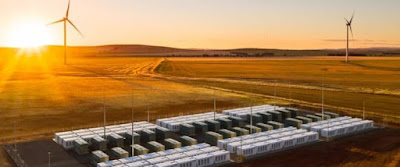Many of us typically do not give much thought to the batteries that power our electronic devices other than when our cell phones, laptops, or EVs run out of juice. Fewer still associate them with our power supply since they tend to be tucked away from sight and are not nearly as imposing as the towering smokestacks of fossil fuel power plants.
Yet, the humble lithium-ion battery is beginning to threaten coal and natural gas power plants as utilities everywhere increasingly plug them into the electric grid.
Indeed, there’s an unfolding trend whereby cheap grid-scale batteries are beginning to replace fossil fuel power plants as the more economical option for supplying extra power during times of peak usage thanks to falling costs. The trend is gaining serious momentum as the transition to renewables shifts into higher gear.
The U.S. Energy Information Administration (EIA) has reported that there were 125 battery storage systems deployed in the United States, accounting for 869 MW of installed power capacity in 2019, a sharp increase from 7 systems accounting for 59 megawatts of power capacity just a decade ago.
In other words, Big Battery is beginning to rival Big Oil for dominance in our power grids, partly thanks to quirks in our power usage patterns.
Peak demand is pricey
Variations in the amount of electricity we consume according to the time of day, between weekdays and weekends, and seasonally can be huge.
For instance, peak power consumption in many regions is nearly double the average amount of power they typically consume. To meet the surge in demand, utilities mostly rely on natural gas-powered plants due to their ability to operate as and when needed and also because of their lower construction costs. However, this practice is expensive and inefficient - and the consumer ends up bearing the extra costs.Related: The Worst Performing Energy Stocks Of 2020
For instance, the California Public Utilities Commission requires all major utilities such as Southern California Edison, Pacific Gas & Electric, and San Diego Gas & Electric to hike electricity prices during weeknights between 4 p.m. and 9 p.m. and also during summer. They also require them to lower costs during non-peak hours and over the winter. The new regulation, also known as time-of-use pricing, is meant to curb the high demand for electricity in the evenings, which forces utility companies to activate additional generators that rely on fossil fuels and release greenhouse gases. Electricity is also more costly to produce during this time. Further, increasing bouts of extreme weather are proving to be costly for utilities, with droughts reducing hydropower, and heat waves causing electricity usage to spike.
But maybe all that California needs is to deploy more battery storage.
When grid-connected batteries supply enough electricity to meet peak demand, utilities neither have to build as many power plants and transmission lines nor fire devices that emit copious amounts of planet-warming gases.
Cheaper batteries
Despite the nearly 15-fold increase in battery-based capacity additions over the past decade, grid-scale lithium-ion battery projects in the U.S. amount to the equivalent of just two medium-sized gas-powered plants.
The United States boasts approximately 1.2 million megawatts of generation capacity, with natural gas accounting for 44% of that, followed by coal at 21%. In other words, the country’s entire grid-scale lithium-ion battery network has a capacity equivalent to just 0.16% that of natural gas.
However, the momentum is clearly shifting to battery storage.
Across California, Texas, New England, and the Midwest, battery grid storage has been proven to be an effective solution for improving operations and bridging gaps when consumers need more power than usual.
Luckily, battery costs as well as solar and wind power costs have come down quite dramatically over the past half-decade. Whereas lithium-ion batteries at 2019 prices are still more expensive than natural gas peaker plants, the battery cost trajectory suggests that by 2030, energy storage will be the more cost-effective option.
Source: The Conversation
As usual, California is leading the way in the green trend of hooking up giant storage systems to power grids.
Pacific Gas & Electric has already received the green light from regulators to build a massive 567.5-megawatt energy-storage battery system near San Francisco, though its bankruptcy could complicate matters.
Hawaiian Electric Company is seeking regulatory approval for a similar project that could establish several hundred megawatts of energy storage. Meanwhile, Puerto Rico Electric Power Authority and Arizona Public Service and both exploring storage options as well.
The mega-battery trend could also mean big business for Tesla Inc.’s (NASDAQ:TSLA) SolarCity.
A month ago, Tesla, in partnership with French renewable energy company Neoen, won yet another contract to install another giant battery storage facility for the Australian Energy Market Operator (AEMO). The 300 MW/450 MWh Victorian Big Battery Project in Geelong will use Tesla’s Megapack technology. Independent analysis has shown that for every $1 invested in the giant project, Victorian homes and businesses will reap more than $2 in benefits.
Neoen’s Hornsdale Power Reserve was able to deliver more than $150 million AUD in cost savings during its first two years of operation.
By Alex Kimani for Oilprice.com


















